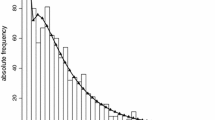Abstract
Three aspects of inequalities in scientific productivity of research units-scientists within RUs, RUs in the full sample and its cross-section, and an aggregate approach, in which components referring to the first two types of inequality were distinguished—was used to analyse the causes underlying unequall productivity. Using inequality measure based on the theory of information (Theil measure) an inverse relationship between volume of productivity and its inequality was empirically found both within research units and among RUs of a given organizational system. Therefore identifying the soruces of variability of output inequalities may be helpful in drawing conclusions regarding to the absolute volumes of scientific productivity of RUs.
Similar content being viewed by others
References
F. M. ANDREWS (Ed.),Scientific Productivity. The Effectiveness of Research Groups in Six Countries, Unesco, Paris, 1979.
R. A. KATZELL, C. E. MILLER, N. G. ROTTER, T. G. VENCT, Effects of leadership and other inputs on group processes and outputs,Journal of Social Psychology, 80 (1970) 157.
P. D. ALLISON, J. A. STEWART, Productivity differences among scientists: Evidence for accumulative advantage,American Sociological Review, 39 August (1974) 596.
W. OKRASA,Effectiveness of Research Units (in polish), PWN, Warszawa, 1984.
See ANDREWS,-op. cit., Ref. 1..
G. LENSKI,Power and Privilege, McGraw-Hill, New York, 1966; P. M. BLAU,Inequality and Heterogeneity, Free Press, New York, 1977; A. B. ATKINSON,The Economics of Inequality, Clarendon Press, Oxford, 1983.
P. D. ALLISON Measures of inequality,American Sociological Review, 43 December (1978) 865; A. SEN,On Economic Inequality, Clarendon Press, Oxford, 1973.
H. THEIL,Statistical decomposition Analysis, North-Holland Publishing Company, Amsterdam, 1972.
P. D. ALLISON, Inequality and scientific productivity,Social Studies of Science, 10 (1980) 163.
J. S. LONG, R. MCGINNIS, Organizational context and scientific productivity,American Sociological Review, 46 August (1981) 422.
L. G. HREBINIAK, Job technology and organizational structure,Administrative Science Quarterly, 19 (1974) 395.
W. OKRASA, Organizational structure and the division of labour within research teams and its impact on performance measures,Science of Science, 4 (1984) 295.
W. ORASA, Analysis of scientific productivity of research teams (in polish),Planowanie i Organizacja Badań Naukowych (Planning and Organization of Scientific Researches), 9 (1986) 42.
T. M. STEINER,Group Process and Productivity, Academic Press, New York, 1972.
J. R. HACKMAN, C. G. MORRIS, Group tasks, group interaction process and group performance effectiveness, in: H. B. BLUMBERG et al. (Eds),Small Groups and Social Interactions, J. Wiley, New York, 1983.
See STEINER,-op. cit., Ref. 14..
A. F. ZANDER, Team spirit vs. the individual achiever, in: BLUMBERG et al., op. cit., Ref. 15. in:.
B. P. COHEN, R. J. KRUZE, M. ANBAR, The model structure of scientific research teams,Pacific Sociological Review, 25 (1982) 205.
M. ARGYLE, Five kinds of small social groups, in: BLUMBERG et al., op. cit., Ref. 15. in:.
HACKMAN and MORRIS,-op. cit., Ref. 15..
J. ZIELENIEWSKI,On Organization of Scientific Researches (in polish), PWE, Warszawa, 1975.
D. V. NIGHTINGALE, J-M. TOULOUSE, Toward a multilevel congruence theory of organiaztion,Administrative Science Quarterly, 22 (1977) 264.
A. TANNENBAUM, B. KOVAĆ, G. WIESER, M. VRANELLO,Hierarchy in Organizations: An International Comparison, Jossey-Bass, San Francisco, 1974.
See COHEN et al.,-op. cit., Ref. 18..
S. M. DORNBUSCH, W. R. SCOTT,Evaluation and the Exercise of Authority, Jossey-Bass, San Francisco, 1975.
H. P. HOLLANDER, J. W. JULIAN, Contemporary trends in the analysis of leadership process,Psychological Bulletin, 71 (1969) 387.
S. E. FIENBERG,The Analysis of Cross-Classified Categorical Data, MIT Press, Cambridge, 1978.
See BLAU,-op. cit., Ref. 6..
See THEIL,-op. cit., Ref. 8..
D. LINDSEY, Further evidence for adjusting for multiple authorship,Scientometrics, 4 (1982) 389.
J. S. LONG, R. MCGINNIS, On adjusting productivity measures for multiple authorship,Scientometrics, 4 (1982) 379.
M. T. HANNAN,Aggregation and Disaggregation in Sociology, Lexington Books, Massachusetts, 1971.
J. R. LINCOLN, G. ZEITZ, Organizational properties from aggregate data: Separating individual and structural effects,American Sociological Review, 45 June (1980) 391.
See THEIL,-op. cit., Ref. 8..
See OKRASA,-op. cit. Ref. 4..
Author information
Authors and Affiliations
Rights and permissions
About this article
Cite this article
Okrasa, W. Differences in scientific productivity of research units: Measurement and analysis of output inequality. Scientometrics 12, 221–239 (1987). https://doi.org/10.1007/BF02016294
Received:
Issue Date:
DOI: https://doi.org/10.1007/BF02016294




